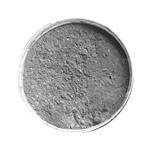The heat of formation is —187 kcal mole-1 and the magnetic moment is 1-60
B.M. at 90°K rising to 2.46 B.M. at 293°K; it is thus a high spin compound but not magnetically dilute.
Anhydrous cobalt(III) fluoride turns dark in the presence of traces of water and reacts violently with the liquid-evolving oxygen. When heated in an inert atmosphere above 350°, cobalt(II) fluoride is formed. It reacts vigorously with many elements, e.g. Al, P, As, S, I, being reduced to cobalt(II) fluoride. It is insoluble in alcohol, ether and benzene and is a useful fluorinating agent in organic chemistry.
Light brown hexagonal crystal; density 3.88 g/cm3; moisture sensitive; stable in dry air; melts at 927°C; reacts with water.
Cobalt(III) fluoride is a powerful fluorinating agent.
Important fluorinating agent, particularly for complete fluorination of hydrocarbons by the Fowler process.
Cobalt(III) fluoride may be prepared by reaction of elemental fluorine with cobalt(II) fluoride, cobalt(II) chloride or cobalt(III) oxide at 300 to 400°C.
2CoF2 + F2 → 2CoF3
2CoCl2 + 3F2 → 2CoF3 + 2Cl2
It should be stored in a sealed glass ampule, free from moisture.
Electrolytic oxidation of cobalt(II) fluoride in 40% hydrofluoric acid yields hydrated cobalt(III) fluoride, CoF3·3.5H2O (3.5 is the stoichiometric amount of water per CoF3 molecule in the crystal lattice).
Strong irritant to tissue.
Structure and conformation
It forms hexagonal crystals of density 3.89, isomorphous with iron(III) and
aluminium(III) fluorides, the cobalt atoms being octahedraily surrounded by fluorine atoms.


